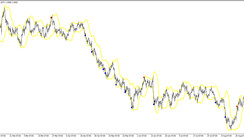The world of trading is filled with myriad strategies, each with its own unique parameters, complexities, and potential. Among these, the Moving Average and Average True Range (ATR) Breakout Strategy stand out for its logical, robust approach, combining key aspects of technical analysis to create a compelling trading framework.
At its core, this strategy utilizes two primary indicators: the 200-period Simple Moving Average (SMA) and the 14-period Average True Range (ATR). The SMA is used to identify the overall market trend, while the ATR is employed as a volatility indicator, providing a clear understanding of market dynamics. Together, they form the basis of the strategy's entry and exit rules.
Entry Rule
The entry rules for this strategy are straightforward. Traders wait for the price to close above the 200-period SMA, signaling a potential upward trend. This is a classic technique used by traders to identify a shift in the market direction. However, the strategy further refines the entry point using the ATR.
The 14-period ATR is calculated next, which gauges market volatility. It measures the average distance that the price moves over a specified number of periods, providing a sense of the market's volatility.
The buy order is placed only when the current price surpasses the previous high by a value equal to 1.5 times the ATR. This breakout signifies that the price movement is not just a random fluctuation, but a potential start of a new uptrend with enough momentum, which is an ideal condition for entry.
Exit Rule
Once the entry point has been determined and a position has been taken, the next crucial step is to define an exit rule. The stop-loss order is set below the recent swing low. This acts as a protective measure, ensuring that if the trade moves against the anticipated direction, losses are limited.
The take-profit level can be set as a fixed target or based on a trailing stop-loss strategy. A fixed target is typically a predetermined price level, while a trailing stop-loss adjusts with the price movement, locking in profits as the price moves favorably. Alternatively, the trade can be exited when the price closes below the 200-period SMA, indicating a possible reversal of the trend.
Position Sizing and Risk Management
Risk management is a pivotal aspect of any trading strategy. In the Moving Average and ATR Breakout Strategy, the position size is determined based on a risk percentage of the account balance. A common practice is to risk 2% of the account per trade.
The position size is calculated based on the difference between the entry price and the stop-loss level. This approach ensures that even if the trade does not work out as expected, the loss is restricted to a manageable portion of the trading account, preserving capital for future trades.
In conclusion, the Moving Average and ATR Breakout Strategy is a comprehensive trading strategy that amalgamates trend identification, volatility measurement, and robust risk management. It's a potent tool for both novice and experienced traders, offering a logical and systematic approach to trading. As with any strategy, it's essential to backtest it thoroughly and use it in conjunction with other market analysis techniques to improve its effectiveness.
Backtesting and Adjustments
Before deploying this strategy live, it is essential to backtest it using historical data. Backtesting allows traders to evaluate the strategy's effectiveness and make necessary adjustments based on the results. It also aids in understanding the potential drawdowns, the risk-to-reward ratio, and the overall profitability of the strategy.
Furthermore, traders should adjust the strategy according to their individual trading style, risk tolerance, and the specific market being traded. For instance, shorter-term traders might prefer to use a smaller period SMA and ATR, while longer-term traders may opt for larger periods.
milarly, the period selection for both the SMA and the ATR can be varied based on the specific market conditions and the trader's risk tolerance. A larger period will provide a slower but more reliable signal, while a shorter period will provide a quicker but possibly more false-prone signal.
Strategy Modifications
While the basic structure of the Moving Average and ATR Breakout Strategy is solid, there is always room for customization based on individual preferences and market conditions. For example, a trader might want to introduce an additional filter, such as only taking trades during certain market hours or avoiding trades during major news events.
Another modification could be using a multiple of the ATR for the stop-loss and take-profit levels. For example, setting the stop-loss at 2 times the ATR below the entry price and the take-profit at 4 times the ATR above the entry price. This would create a predefined risk-to-reward ratio and could potentially enhance the profitability of the strategy.
The Importance of Discipline and Patience
Even the best trading strategy will fail without trader discipline and patience. The Moving Average and ATR Breakout Strategy requires waiting for the right setup, which might not occur every trading day. Trying to force a trade when the conditions are not met can lead to unnecessary losses.
Similarly, once a trade is placed, it's crucial to stick to the predefined stop-loss and take-profit levels, unless there's a significant change in market conditions. Moving these levels based on emotions like fear or greed can quickly erode the effectiveness of the strategy.
Final Words
In conclusion, the Moving Average and ATR Breakout Strategy is a versatile and effective trading strategy when used correctly. Its strength lies in its simplicity, clear rules, and robust risk management. However, it is not a magic formula for success. Traders should always conduct thorough backtesting, apply sound money management principles, and continually learn and adapt to succeed in the dynamic world of trading.





